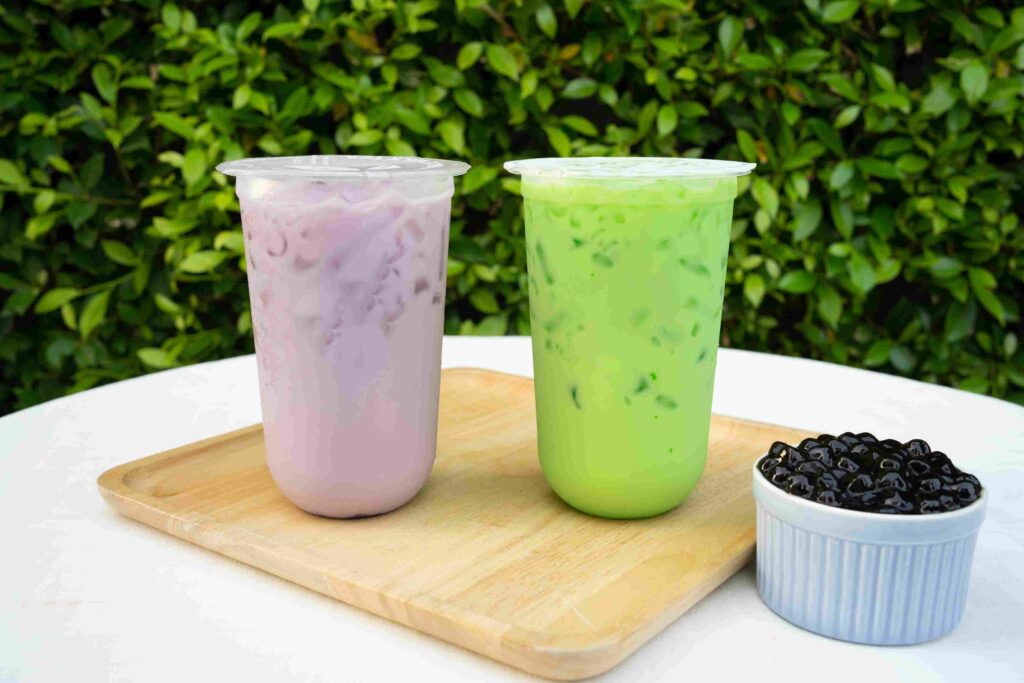Taro is a starchy root vegetable that is widely consumed in various cuisines around the world. It is known for its unique flavor and versatility in cooking. If you have ever wondered what Taro tastes like, you have come to the right place. In this article, we will explore the taste profile of Taro and provide a comprehensive understanding of its flavor characteristics.
What Is Taro?
Taro, scientifically known as Colocasia esculenta, is a starchy root vegetable that belongs to the Araceae family. It is widely cultivated and consumed in many parts of the world, particularly in tropical and subtropical regions.
Taro has been a staple food in various cuisines for centuries and is valued for its versatile culinary uses. The plant has large heart-shaped leaves and grows in moist soil or waterlogged conditions. The tuberous root of Taro is the edible part, which can vary in color from white to purple depending on the variety. It has a mildly sweet and nutty flavor, similar to a potato’s, but with a slightly slimy texture when cooked.
Taro is used in various dishes, such as soups, stews, curries, chips, and desserts. It is also processed into flour or starch for various food products. Besides its culinary significance, Taro holds cultural importance in many societies and has been used in traditional medicine for its potential health benefits.
What Is Taro Milk Tea?

Taro milk tea is a popular beverage that originated in Taiwan and has gained popularity worldwide. It combines taro root, a starchy tuber with a subtly sweet and nutty flavor, milk, and tea. The taro root is typically cooked, mashed, and blended with milk to create a creamy base. This mixture is then combined with brewed tea, usually black or green tea, and sweetened with sugar or other sweeteners to taste. Taro milk tea can be served hot or cold and is often topped with tapioca pearls or other toppings for added texture. It offers a unique and enjoyable flavor profile that combines the earthiness of Taro with the creaminess of milk and the aromatic qualities of tea.
Is Taro Good For You?
Taro, also known as Colocasia esculenta, is a starchy root vegetable widely consumed in many parts of the world. It is a good source of various nutrients and can benefit overall health. Taro is rich in dietary fiber, which aids in digestion and helps prevent constipation. It also contains essential vitamins and minerals such as vitamins E, C, potassium, magnesium, and manganese. These nutrients support immune function, maintain healthy skin, regulate blood pressure, and promote bone health. Additionally, Taro is low in fat and calories, making it a suitable option for those watching their weight. However, it is essential to note that Taro should be cooked thoroughly before consumption to remove potentially harmful toxins.
What Does Taro Taste Like?
Taro, a starchy root vegetable, has a unique taste that can be described as mildly sweet and nutty with a hint of earthiness. Its flavor is often compared to a combination of potatoes and chestnuts. The texture of cooked Taro is smooth and creamy, similar to that of a potato but slightly denser. Taro is commonly used in various cuisines worldwide, including Asian, African, and Caribbean dishes. It is versatile and can be prepared in numerous ways, such as boiling, steaming, frying, or baking. Its taste can vary slightly depending on the cooking method and the specific variety of Taro used.
What Are The Health Benefits Of Taro Root?
Taro root, also known as Colocasia esculenta, is a starchy tuber that offers various health benefits. Firstly, it is a good source of dietary fiber, which aids in digestion and helps prevent constipation. Additionally, taro root is rich in vitamins and minerals such as E, C, potassium, and magnesium, contributing to overall health and well-being. These nutrients support immune function, promote healthy skin, regulate blood pressure levels, and maintain proper muscle and nerve function.
Taro root also contains antioxidants that help protect the body against oxidative stress and reduce the risk of chronic diseases. Moreover, it has a low glycemic index, making it suitable for individuals with diabetes or those aiming to manage their blood sugar levels. However, it is essential to note that taro root should be cooked thoroughly before consumption to remove any potentially harmful toxins.
How To Use Taro – Taro Recipes
Here is how to use Taro with some delicious recipes.
Taro Chips:
Taro chips are a popular snack that can be enjoyed alone or served with dips. Here’s how to make crispy taro chips:
Ingredients:
- Two medium-sized taro roots
- Vegetable oil for frying
- Salt (optional)
Instructions:
- Peel the Taro into thin, even slices using a mandoline or a sharp knife.
- Rinse the sliced Taro under cold water to remove excess starch.
- Pat the taro slices dry with a paper towel.
- Heat vegetable oil in a deep fryer or a large pot to around 350°F (175°C).
- Carefully drop a few taro slices into the hot oil and fry until golden brown and crispy, about 3-4 minutes.
- Remove the fried taro chips from the oil using a slotted spoon and place them on a paper towel-lined plate to drain excess oil.
- Sprinkle with salt if desired, and let them cool before serving.
Taro Mash
Taro can be used as a delicious alternative to mashed potatoes. Here’s how to make creamy taro mash:
Ingredients:
- Two medium-sized taro roots
- Two tablespoons butter
- 1/4 cup milk or cream
- Salt and pepper to taste
Instructions:
- Peel, rinse and cut the Taro into cubes.
- Place the cubed Taro in a pot of boiling water and cook until tender, about 15-20 minutes.
- Drain the cooked Taro and return it to the pot.
- Add butter, milk or cream, salt, and pepper to the pot.
- Mash the Taro using a potato masher or an immersion blender until smooth and creamy.
- Adjust the consistency by adding more milk or cream if desired.
- Serve hot as a side dish with your favorite main course.
Taro Dessert: Taro Coconut Milk Pudding
Taro can also be used in sweet desserts, such as this delightful taro coconut milk pudding:
Ingredients:
- Two medium-sized taro roots
- One can (13.5 oz) of coconut milk.
- 1/4 cup sugar (adjust to taste)
- 1/4 teaspoon vanilla extract (optional)
- Chopped nuts or shredded coconut for garnish (optional)
Instructions:
- Peel, rinse and cut the Taro into small cubes.
- Place the taro cubes in a pot with enough water to cover them and bring to a boil. Cook until the Taro is tender, about 15-20 minutes.
- Drain the cooked Taro and transfer it to a blender or food processor.
- Add coconut milk, sugar, and vanilla extract to the blender and blend until smooth.
- Pour the mixture back into the pot and heat over medium heat until it thickens slightly, stirring constantly.
- Remove from heat and let it cool for a few minutes.
- Transfer the pudding into serving bowls or ramekins and refrigerate until set, usually for a few hours.
- Garnish with chopped nuts or shredded coconut before serving if desired.
Depending on these recipes is not enough. If you use Taro, you get unlimited cooking options. Besides these recipes, you can also use Taro to make taro bubble tea or taro ice cream at home easily.
Conclusion
In conclusion, Taro is a versatile root vegetable with a unique and distinct taste. Its flavor can be described as mildly sweet with nutty undertones, similar to a combination of potato and chestnut. The texture of cooked Taro is smooth and creamy, making it a popular ingredient in various culinary dishes worldwide. Whether boiled, steamed, fried, or mashed, Taro adds a delightful earthy flavor to savory and sweet recipes. Its versatility allows it to be used in soups, stews, curries, desserts, and even beverages. Taro’s taste may vary slightly depending on the cooking method and the specific taro variety. Overall, Taro provides a unique culinary experience that is worth exploring.
Frequently Asked Questions (FAQ’s)
Is Taro Milk Tea Sweet?
Yes, Taro Milk Tea is typically sweet. The sweetness level can vary depending on personal preference and the recipe used.
Does Taro Taste Like Vanilla?
Taro does not taste like vanilla. Taro has a unique flavor that is often described as nutty, earthy, and slightly sweet, while vanilla has a distinct sweet and floral taste.
Is Taro Healthy?
Taro is a highly nutritious root vegetable that offers numerous health benefits. It is rich in fiber, vitamins, and minerals and has been associated with improved digestion, heart health, and immune function.
What Does Taro In Boba Taste Like?
Taro boba has a unique and distinct flavor often described as sweet, nutty, and slightly vanilla-like. It adds a creamy and earthy taste to the overall boba drink. The flavor of Taro can vary depending on the preparation method and the other ingredients used in the boba drink.
What Does Taro Taste Similar To?
Taro has a unique flavor that is difficult to compare directly to other foods. However, some people describe its taste as a combination of sweet potato, chestnut, and artichoke. The flavor can vary depending on how it is prepared and cooked.
Does Taro Taste Fishy?
Taro is a starchy root vegetable commonly used in various cuisines around the world. While it has a distinct flavor, it does not taste fishy. Taro has a mild and slightly sweet taste, often described as nutty or earthy. Its flavor can vary depending on how it is prepared and cooked.
Does Taro Have Caffeine?
Taro does not contain caffeine. It is a root vegetable commonly used in cooking and does not naturally contain caffeine.
Why Is Taro Purple?
Taro is purple due to the presence of natural pigments called anthocyanins, specifically delphinidin and cyanidin. These pigments are responsible for the vibrant purple coloration observed in Taro.






